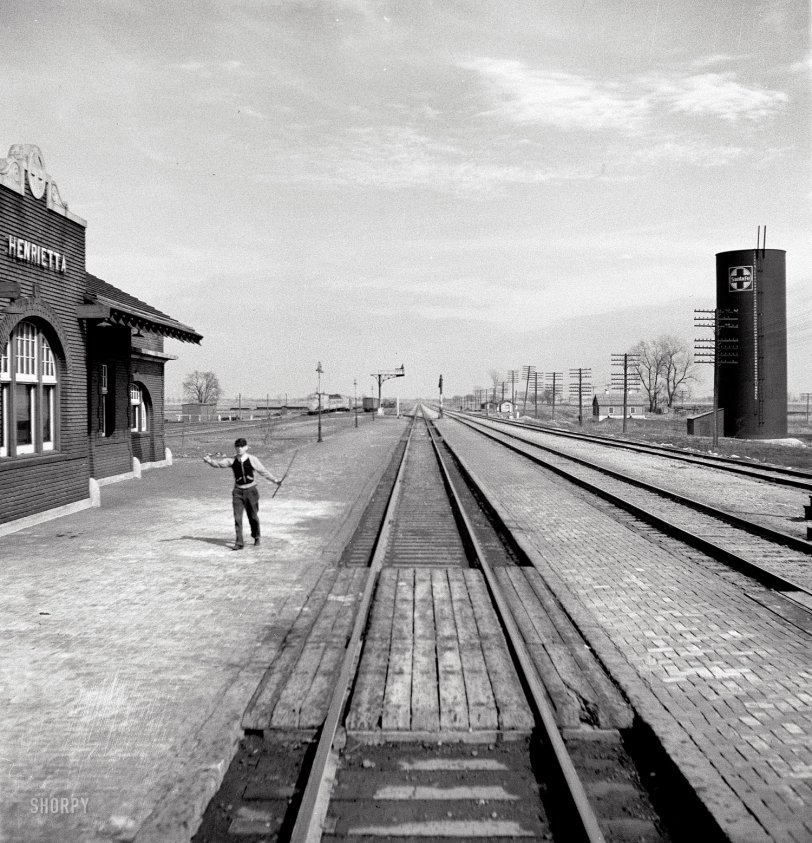


Framed or unframed, desk size to sofa size, printed by us in Arizona and Alabama since 2007. Explore now.
Shorpy is funded by you. Patreon contributors get an ad-free experience.
Learn more.

- Texas Flyer wanted
- Just a Year Too Soon
- WWII -- Replacing men with women at the railroad crossing.
- Yes, Icing
- You kids drive me nuts!
- NOT An Easy Job
- I wonder
- Just add window boxes
- Icing Platform?
- Indiana Harbor Belt abides
- Freezing haze
- Corrections (for those who care)
- C&NW at Nelson
- Fallen Flags
- A dangerous job made worse
- Water Stop
- Passenger trains have right of way over freights?
- Coal
- Never ceases to amaze me.
- Still chuggin' (in model form)
- Great shot
- Westerly Breeze
- For the men, a trapeze
- Tickled
- Sense of loneliness ...
- 2 cents
- Charm City
- What an Outrage
- Brighton Park
- Catenary Supports
Print Emporium
Henrietta: 1943

March 1943. "Henrietta, Missouri. Going through the town on the Atchison, Topeka, and Santa Fe Railroad between Marceline, Missouri, and Argentine, Kansas. The operator has just handed up a message." Medium-format nitrate negative by Jack Delano for the Office of War Information. View full size.
Santa Fe
The railroad was just the Atchison & Topeka at first; Santa Fe was added as a goal. In fact the main line went to Lamy, not Santa Fe, with a minor branch to SF added later. Can't write a song about Lamy.
But the rhyme in the song didn't work for the many folks who pronounced it Santa Fee. Before the popular song came along, the railroad tried to correct this by spreading the slogan "All the way with Santa Fe!" The slogan caught on, but it didn't help. Dismayed station agents would hear customers saying things like "Yep, I like that slogan. All the way with Santa Fee!"
Naming Railroads
Atchison, Topeka (and the) Santa Fe sounds great. It's also the route of the railroad from east to west. It all worked out for the best.
Poetry
Who was the inspired wordsmith who named the Atchison, Topeka, and Santa Fe? Its founder Cyrus K. Holliday, apparently, and as far as I can see the poetry of its name was a happy coincidence of the significant placenames. Maybe their rhythmic ordering was an artistic decision: even "Topeka, Atchison & Sante Fe" wouldn't have the same ring to it.
This ties several photos together
Here is the operator having delivered train orders to the engine and train crews walking back to his office after inspecting the train and waving "all OK" to the brakeman or flagman at the rear car. In the distance you can see the water column between the two main tracks for steam locomotives. Beyond that is a cantelevered bridge supporting a semaphore signal with its blade having already descended to the horizontal position for "stop." Before the train arrived at this location, the semaphore would have been vertical to indicate "proceed." Soon when the train is clear of the next signal ahead (perhaps a mile or more down the track), this semaphore will rise to a 45-degree angle indicating "approach," meaning slow to 30 mph and be prepared to stop at the next signal.
Today this route is owned and operated by the BNSF Railway and hosts 75 or more freight trains each day plus two Amtrak Southwest Chiefs that operate between Chicago and Los Angeles.
Henrietta Depot today
Someone had to say it
Do you hear that whistle down the line?
I figure that it's engine number forty-nine,
She's the only one that'll sound that way.
On the Atchison, Topeka and the Santa Fe.
























On Shorpy:
Today’s Top 5